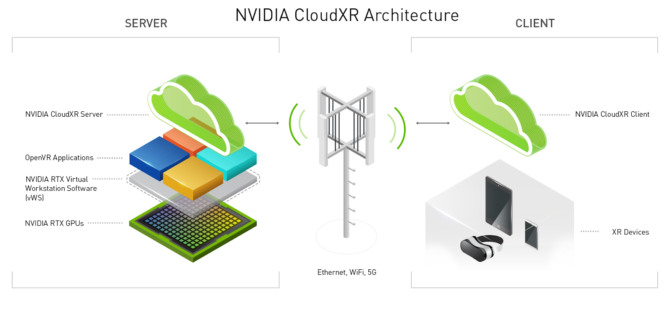NVIDIA technology has been behind some of the world’s most stunning virtual reality experiences.
Each new generation of GPUs has raised the bar for VR environments, producing interactive experiences with photorealistic details to bring new levels of productivity, collaboration and fun.
And with each GTC, we’ve introduced new technologies and software development kits that help developers create extended reality (XR) content and experiences that are more immersive and delightful than ever.
From tetherless streaming with NVIDIA CloudXR to collaborating in a virtual world with NVIDIA Omniverse, our latest technologies are powering the next generation of XR.
This year at GTC, NVIDIA announced a new release for CloudXR that adds support for iOS. We also had announcements with leading cloud service providers to deliver high-quality XR streaming from the cloud. And we released a new version of Variable Rate Supersampling to improve visual performance.
Bringing High Performance and VR Mobility Together
NVIDIA CloudXR is an advanced technology that gives XR users the best of both worlds: the performance of NVIDIA GPUs with the mobility of untethered all-in-one head-mounted displays.
CloudXR is designed to stream all kinds of XR content from any server to any device. Users can easily access powerful, high-quality immersive experiences from anywhere in the world, without being physically connected to a workstation.
From product designers reviewing 3D models to first responders running training simulations, anyone can benefit from CloudXR using Windows and Android devices. We will soon be releasing CloudXR 2.1, which adds support for Apple iOS AR devices, including iPads and iPhones.
Taking XR Streaming to the Cloud
With 5G networks rolling out, streaming XR over 5G from the cloud has the potential to significantly enhance workflows across industries. But the big challenge with delivering XR from the cloud is latency — for people to have a great VR experience, they have to maintain 20ms motion-to-photon latency.
To deliver the best cloud streaming experience, we’ve fine-tuned NVIDIA CloudXR. Over the past six months, we’ve taken great strides to bring CloudXR streaming to cloud service providers, from Amazon Web Services to Tencent.
This year at GTC, we’re continuing this march forward with additional news:
- CloudXR is available on Amazon Marketplace as an Amazon Machine Image (AMI)
- The CloudXR platform will be available on NVIDIA GPU-powered virtual machine instances on Azure
Also at GTC, Google will present a session that showcases CloudXR running on a Google Cloud instance.
To support CloudXR everywhere, we’re adding more client devices to our family.
We’ve worked with Qualcomm Technologies to deliver boundless XR, and with Ericsson on its 5G radio and packet core infrastructure to optimize CloudXR. Hear about the translation of this work to the manufacturing environment at BT’s session in GTC’s XR track.
And we’ve collaborated with Magic Leap on a CloudXR integration, which they will present at GTC. Magic Leap and CloudXR provide a great step forward for spatial computing and an advanced solution that brings many benefits to enterprise customers.
Redefining the XR Experience
The quality of visuals in a VR experience is critical to provide users with the best visual performance. That’s why NVIDIA developed Variable Rate Supersampling (VRSS), which allows rendering resources to be focused in a foveated region where they’ll have the greatest impact on image quality.
The first VRSS version supported fixed foveated rendering in the center of the screen. The latest version, VRSS 2, integrates dynamic gaze tracking, moving the foveated region where the user is looking.
These advances in XR technology are also paving the way for a solution that allows users to learn, work, collaborate or play with others in a highly realistic immersive environment. The CloudXR iOS integration will soon be available in NVIDIA Omniverse, a collaboration and simulation platform that streamlines 3D production pipelines.
Teams around the world can enter Omniverse and simultaneously collaborate across leading content creation applications in a shared virtual space. With the upcoming CloudXR 2.1 release, Omniverse users can stream specific AR solutions using their iOS tablets and phones.
Expanding XR Workflows at GTC
Learn more about these advances in XR technology at GTC. Register for free and explore over 40 speaker sessions that cover a variety of XR topics, from NVIDIA Omniverse to AI integrations.
Check out the latest XR demos, and get access to an exclusive Connect with Experts session.
And watch a replay of the GTC keynote address by NVIDIA CEO Jensen Huang to catch up on the latest announcements.
Sign up to get news and updates on NVIDIA XR technologies.
Feature image credit: Autodesk VRED.
The post NVIDIA Advances Extended Reality, Unlocks New Possibilities for Companies Across Industries appeared first on The Official NVIDIA Blog.

